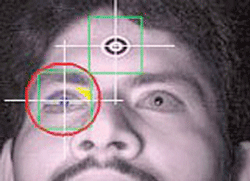A test of involuntary eye movement “accurately indicates attention deficit hyperactivity disorder (ADHD),” according to a new study by researchers at Tel Aviv University in Israel.
However, more research is needed to confirm whether this test is truly accurate.
ADHD is one of the most common neurobehavioral disorders in children in America, according to the Centers for Disease Control and Prevention. But it can be tricky to diagnose. Currently, there is no single objective test to diagnose ADHD, and many other disorders—anxiety, depression and certain types of learning disabilities—can have similar symptoms.
 |
|
| Researchers assessed visual attention using eye tracking to reach a diagnosis of ADHD. Photo SR Research. |
“We had two objectives going into this research,” says lead author Moshe Fried, PhD, who was diagnosed with ADHD as an adult. “The first was to provide a new diagnostic tool for ADHD. The second was to test whether ADHD medication really works—and we found that it does. There was a significant difference between the two groups, and between the two sets of tests taken by ADHD participants unmedicated and later medicated.”
In the study, the researchers administered a computer test, the Test of Variables of Attention (TOVA), to two groups of 22 adults. The first group of participants, already diagnosed with ADHD, initially performed the 22-minute test unmedicated and then took it again after a prescribed dose of methylphenidate, known as the brand name Ritalin (Novartis). The second group, not diagnosed with ADHD, constituted the control group. The researchers also used an eye-tracking system to monitor the participants’ involuntary eye movements as they took the tests.
“We found that the average microsaccade and blink rates were higher in the ADHD group, especially in the time interval around stimulus onset,” the researchers concluded. In other words, the study showed a direct correlation between ADHD and the inability to suppress eye movement in the anticipation of visual stimuli. The study also showed that methylphenidate does work. “It is certainly not a placebo, as some have suggested,” Dr. Fried says.
He adds, “This test is affordable and accessible, rendering it a practical and foolproof tool for medical professionals. With other tests, you can slip up, make ‘mistakes’—intentionally or not. But our test cannot be fooled. Eye movements tracked in this test are involuntary, so they constitute a sound physiological marker of ADHD.”
Sound, maybe, but the term “foolproof” is inappropriate for scientific publications, says Darrell G. Schlange, OD, DOS, an associate professor at Illinois College of Optometry, whose research in pediatric vision includes reading eye movements and ADHD.
Also, Dr. Schlange says, the size of the test group in this study was insufficient to state that involuntary eye movements “accurately reflect” the presence of ADHD. “This is impressive research, but more is needed to more fully understand the complexities of oculomotor testing for attention disorders, including ADHD,” he says.
To that end, the researchers are currently conducting more extensive trials on larger control groups to further explore applications of the test.
For information about the diagnosis of ADHD, visit: www.cdc.gov/ncbddd/adhd/diagnosis.html.
See also “How to Handle a Hyper Kid,” page 84.
Fried M, Tsitsiashvili E, Bonneh YS, et al. ADHD subjects fail to suppress eye blinks and microsaccades while anticipating visual stimuli but recover with medication. Vision Res. 2014 Aug;101:62-72.

